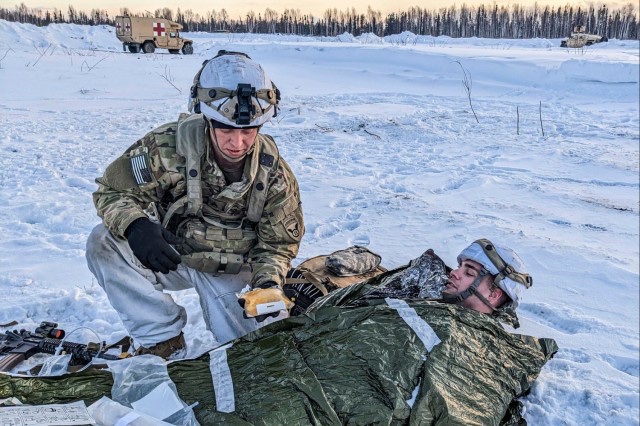
FORT WAINWRIGHT, Alaska — Team members with U.S. Army Medical Materiel Development Activity participated in an arctic conditions assessment of its freeze-dried plasma, or FDP, program recently, partnering with the 11th Airborne Division at Fort Wainwright, Alaska to assess performance of its plasma kits as part of the Joint Pacific Multinational Readiness Center exercise last month.
During the assessment in Alaska, 11th Airborne Division medical providers, conducted scenario-based training for casualty treatment in real-world conditions. These scenarios included mass-casualty training, frontline field treatments and airborne operations to test the FDP kits in conditions paratroopers may face during combat operations.
Assessments of treatments, products and devices, including FDP, are critical to the development process of the lifesaving technologies designed for the rigors of U.S. combat operations. Exposure to extreme elements, like the blistering cold found at Fort Wainwright, help serve as proof-of-concept for products like FDP, according to Andy Atkinson, FDP product manager with USAMMDA’s Warfighter Protection and Acute Care Project Management Office, known as WPAC PMO.
“We really value the input from individual Soldiers on FDP’s performance during an airborne operation in the Arctic,” said Atkinson. “Freezing temperatures create unique challenges for medical products which can degrade with repeated freeze-thaw cycles. The Soldiers didn’t see that with FDP and the overall resounding feedback from the field was positive, with Soldiers eager to get their hands on this product. That’s really valuable feedback for the program office.”
USAMMDA’s WPAC PMO has been developing both human and canine FDP since 2010 as part of its modernization efforts in support of medical providers in the U.S. military joint forces — plasma and other blood products are a key focus of the U.S. Army and the Department of Defense’s medical development efforts to help prepare warfighters for tomorrow’s wars.
A distinct advantage of FDP over similar blood products designed in previous years is its durability and suitability for use as close to the point-of-injury as possible — placing expeditionary FDP in the hands of medics, corpsmen and medical officers to begin blood replacement in the critical minutes and hours after injury, according to Lindsey Garver, Ph.D., deputy project manager with WPAC.
“FDP provides a shelf-life and storage conditions that allow it to be used as far forward as Role 1,” said Garver, referring to medical care provided by first responders at the unit level. “It could be stockpiled offering a significant logistical advantage over whole blood for hemorrhage control. It is one of several blood components USAMMDA has in development to supplement the blood supply on the battlefield.”
The WPAC team is leading the development efforts for both human and canine FDP, partnering with stakeholders across the Department of Defense and non-DOD medical development partners. A critical component of the FDP development process is the feedback gained through touchpoints to assess both the current needs of the frontline medical providers and the utility of FDP in its current state of development. Responses from potential end-users like the medical providers with 11th Airborne Division help the WPAC team refine their approach during all phases of development, according to Garver.
“FDP is one component of blood that can be used for transfusion; it can also be used to maintain a service member at or near the point-of-injury as a bridge to transfusion,” said Garver. “In the case of the 11th Airborne Division partnership, it allowed us to understand how FDP would be used in an Arctic environment, how the product and packaging held up during airborne operations with combat medics, ease of use and if it performed to standard at both the point-of-injury and battalion aid station level of care. There is significant interest in ensuring a safe and substantial blood supply is available to our warfighters in environments with contested logistics and evolving battlefield scenarios. FDP is a critical part of that.”
Blood plasma, the liquid part of blood, “contains important proteins and other substances crucial to one’s overall health,” according to the American Red Cross. U.S. military medical providers have used plasma since at least WWII due to its lifesaving properties when no or limited supply of whole transfusable blood is available.
Given the wide range of possible future battlefields, it is important to develop, test and field blood products, including FDP, that are approved by the Food and Drug Administration; user-friendly; and expeditionary, according to Kendra Lawrence, Ph.D., the WPAC program manager with USAMMDA. Near real-time feedback from intended end users, including the evaluation of FDP in partnership with 11th Airborne Division during JPMRC, gives the WPAC development team insight into current progress of FDP and to cater the product with the end-user in mind.
“The JPMRC exercise and collaboration with 11th Airborne Division was a unique opportunity for the program office to gain real-world user feedback on the performance of a life-saving blood product in an artic environment,” said Lawrence, herself an Army and Iraq War Veteran. “Importantly, they showed that freeze-dried plasma is resilient, transportable, and easy to use under austere freezing conditions.”
By T. T. Parish


Really glad they’re taking time and getting this right. The Germans used FDP quite a bit very early in GWOT so there should be plenty of data out there, but I’m excited about potential for this to be pushed out to Rural EMS where blood programs are next to impossible. Would be a huge step in the right direction to have a volume replacement with fewer hemodilution concerns for those guys.
Still wrapping people in plastic????
Wrapping people in plastic might help with some convective heat loss but is not the way to achieve normothermia…